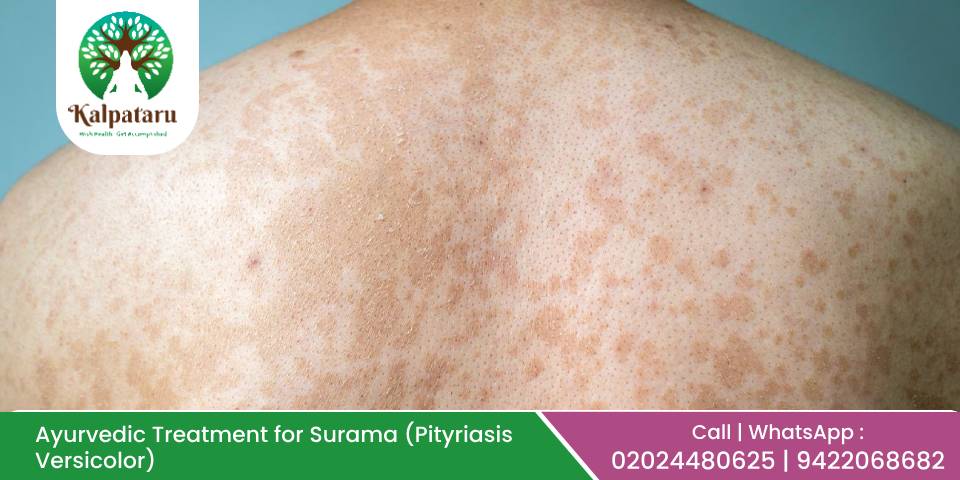Surama, known in modern medicine as Pityriasis Versicolor, is a common superficial fungal skin infection caused by the Malassezia yeast. It presents as discolored patches on the skin—typically on the trunk, neck, and upper arms—which may appear lighter or darker than the surrounding skin. In Ayurveda, Surama is explained as a skin disorder that appears due to the imbalance of doshas, primarily Pitta and Kapha, along with Rakta Dusti (vitiation of blood) and weakened immunity.
This blog will help you understand the condition from an Ayurvedic perspective and explore natural, holistic remedies to manage it effectively.
What is Surama (Pityriasis Versicolor)?
Pityriasis Versicolor is a superficial fungal infection induced by the overgrowth of Malassezia yeast, which is naturally present on the skin. When the yeast grows excessively due to heat, humidity, oily skin, or a weakened immune system, it leads to scaly patches that are lighter or darker than the surrounding skin. These patches typically arise on the back, chest, neck, and upper arms.
In Ayurveda, Surama is classified under Kushtha Roga (skin diseases), more specifically Kshudra Kushtha, as it is a minor skin condition. Surama is mostly a result of the Kapha-Pitta dosha imbalance in the body and the accumulation of toxins (Ama) in the skin.
Causes of Surama in Ayurveda:
According to Ayurvedic principles, skin disorders are the result of internal imbalances rather than just external factors. The primary causes of Surama are:
- Viruddha Ahara (incompatible food combinations)
- Excessive intake of oily, spicy, and junk foods
- Excessive exposure to heat and humidity
- Lack of skin hygiene
- Stress and irregular sleep
- Weak digestion and accumulation of Ama (toxins)
- Low immunity (Ojakshaya)
When the digestive fire (Agni) weakens, it leads to the formation of Ama, which combines with vitiated Kapha and Pitta doshas to manifest as skin discoloration and scaling — characteristic features of Surama.
Symptoms of Surama (Pityriasis Versicolor):
- Discolored patches that may be lighter or darker than the surrounding skin
- Mild itching, specifically when the body is sweaty
- Scaling or flaking of skin
- Typically seen on the upper chest, back, neck, and arms
- Recurrence during summer or after sweating
- Cosmetic concern due to visible patches
- Recurrence is common without proper management
Ayurvedic Management of Surama:
Ayurveda emphasizes a holistic, natural treatment for skin conditions. The goal is to purify the body, balance the doshas, and strengthen the immune system to prevent recurrence.
1. Shodhana Chikitsa (Detoxification):
To eliminate the root cause (toxins and doshic imbalance), Ayurvedic cleansing therapies are recommended:
- Vamana (Therapeutic Emesis): Particularly useful when Kapha dosha is dominant. Helps in removing accumulated toxins from the upper digestive tract.
- Virechana (Therapeutic Purgation): Helps in pacifying Pitta dosha and cleansing the liver and intestines.
- Raktamokshana (Bloodletting): Removes impure blood and reduces skin-related ailments.
- Abhyanga (Herbal oil massage) followed by Swedana (steam therapy) helps improve circulation and cleanse the skin pores.
2. Shamana Chikitsa (Pacifying Therapy):
This includes internal herbal medications and topical applications to balance the doshas and restore skin health.
Internal Medications:
- Arogyavardhini Vati: Detoxifies the liver and enhances skin health.
- Gandhak Rasayana: Purifies blood and has antifungal properties.
- Khadirarishta: A classical formulation for various skin diseases.
- Manjishtha (Rubia cordifolia): A potent blood purifier and skin rejuvenator.
- Kaishor Guggulu – Works well in chronic skin infections by purifying blood and removing toxins.
- Neem (Azadirachta indica): A powerful antimicrobial and anti-inflammatory herb.
- Haridra (Turmeric): Balances all three doshas and prevents skin infections.
External Applications:
- Triphala decoction wash: Cleanses the affected area.
- Neem oil , mahamarichyadi oil,karanj oil, Nalpamaradi oil: Applied externally to reduce fungal activity and nourish the skin.
- Lepa (herbal paste): A paste of turmeric, sandalwood, and manjishtha applied to impacted areas aids decrease discoloration and itching.
3. Local Applications (Bahya Chikitsa):
Ayurveda recommends natural, antifungal external applications to reduce fungal colonization and support skin healing.
Herbal Pastes and Oils:
- Neem Paste: Antifungal and antibacterial; reduces itching and discoloration.
- Khadira Churna Paste: Useful in fungal and allergic skin conditions.
- Jatyadi Taila: Heals injured skin and controls further fungal growth.
- Durvadi Taila: Soothe inflamed skin patches and promote tissue repair.
Home Remedies:
- Turmeric + Coconut Oil: Make a paste and apply to affected areas. Turmeric is a natural antifungal agent, and coconut oil soothes and moisturizes the skin.
- Multani Mitti + Neem Powder: A cooling and antifungal face/body pack.
- Apple Cider Vinegar (Diluted): Used externally, helps in balancing skin pH and controlling yeast growth.
Diet and Lifestyle Recommendations:
Ayurveda places significant importance on Ahara (diet) and Vihara (lifestyle) to maintain skin health and control the recurrence of Surama.
Dietary Guidelines:
- Avoid oily, spicy, and junk food.
- Stay away from dairy and sugary foods that increase Kapha.
- Include bitter vegetables like neem, bitter gourd, and fenugreek.
- Drink warm water infused with turmeric or cumin to aid digestion.
- Avoid curd, particularly at night.
Lifestyle Modifications:
- Bathe regularly and keep skin dry, especially in humid weather.
- Wear breathable, cotton clothing.
- Avoid excessive sweating and sun exposure.
- Practice stress-reducing techniques like yoga and meditation.
- Maintain a regular sleep schedule to keep the body’s rhythms balanced.
Seasonal Detox:
- Undergo seasonal Panchakarma detox once or twice a year to cleanse accumulated doshas, especially before summer or monsoon.
Preventive Measures in Ayurveda:
- Dinacharya (daily routine): Includes regular oil massage and proper bathing habits to sustain skin health.
- Ritucharya (seasonal regimen): Modify food and lifestyle according to the seasons to avoid aggravation of doshas.
- Boost immunity with regular use of Rasayana herbs like Guduchi, Amalaki, and Ashwagandha.
When to Consult an Ayurvedic Practitioner?
While mild cases of Surama may be controlled with home remedies and herbal support, you should consult an Ayurvedic expert if:
- The infection is recurring despite treatment.
- It spreads to large areas of the body.
- You have other associated conditions like diabetes or obesity.
- Itching or discomfort is intense.
Conclusion:
Surama (Pityriasis Versicolor) may seem like a superficial skin problem, but its root lies deep within the body’s internal imbalances. Ayurveda offers a time-tested, natural approach to treating this condition — not just by clearing the skin but by rejuvenating the whole body. Through a blend of detox therapies, herbal medicines, dietary corrections, and lifestyle practices, Ayurveda ensures a long-lasting cure and prevents recurrence.
If you are suffering from Surama or any chronic skin condition, consult with the best Ayurvedic Doctor in Pune. At Kalpataru Ayurvediya Chikitsalaya™, Dr. Manoj Deshpande provides personalized Ayurvedic treatments for skin diseases, ensuring a holistic path to healing and well-being.
Book your consultation today and experience the power of Ayurveda in healing from within.

